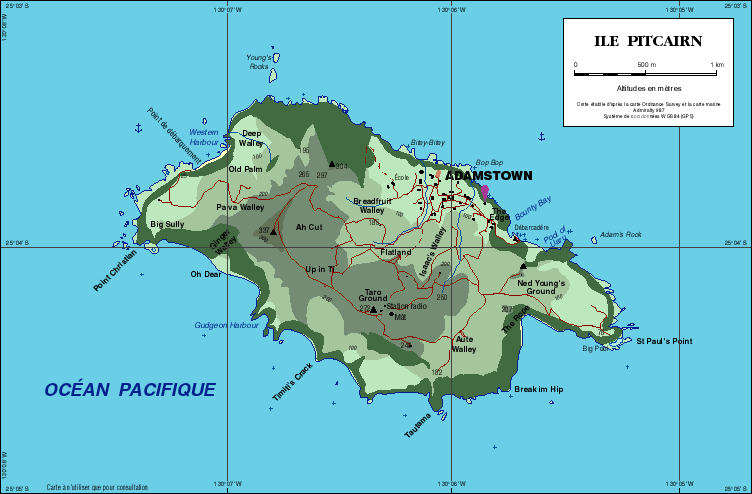

| |
| MAIN OH2BR QRGs NEWS PITCAIRN SPONSORS LOGS GUESTBOOK | www.qsl.net |

Polynesians may have settled Pitcairn as long as 3500 years ago, at least temporarily, and archaeologists believe there was a Polynesian settlement on the island between the 12th and 15th centuries AD. At that time, a lively trade was carried on between Pitcairn, Henderson - which was inhabited as well - and Mangareva, in what is now the Gambier Archipelago of south-eastern French Polynesia. These earlier settlements left burial sites containing human skeletons, petroglyphs, earth ovens, stone adzes and other artefacts, although no one is sure where the original Pitcairners came from. Pitcairn is likely to have been important for its quarry where stone adzes were mined. Despite Pitcairn's diminutive size, its fertile volcanic soils were (and still are) able to support a permanent population. By 1606, when Spanish explorer de Quiros came looking for his own personal El Dorado and found Henderson, both it and presumably Pitcairn were deserted.
Pitcairn's European discovery had to wait until 1767, when Philip Carteret sailed by on HMS Swallow and mischarted it by 300km (186mi). Carteret decided to name it Pitcairn's Island after the man who first spotted it. Meanwhile, HMS Bounty sailed from England in 1787 to collect cuttings from breadfruit trees to take to the West Indies. It was believed (wrongly, as it later turned out) that the breadfruit would make an ideal and cheap food for slaves working the British plantations there. The Bounty stayed in Tahitian waters for five months, during which time (if you've seen any of the five movie versions you'll know) some of the lonely sailors indulged in a little parallel parking with some of the Tahitian princesses, meaning the sailors were none too happy to leave. As you'll know, Fletcher Christian led them in a rebellion against Captain Bligh three weeks after they'd left Tahiti, setting Bligh and 18 crewmen loyal to him out on the open ocean in a longboat and taking the Bounty back to Tahiti. Bligh and his crew eventually made it to Kupang in present day Indonesia.
In January 1790 the mutineers arrived at Pitcairn after a couple of false starts during a four month search for a hideaway far from British naval justice. Led by Christian, the party included eight other mutineers, six Tahitian men, 12 Tahitian women and a child. A few days later the mutineers burned their bridges in Bounty Bay as the good ship Bounty went up in smoke. Despite good intentions to peacefully co-exist, within a couple of years the new Pitcairners embarked on their own Lord of the Flies big adventure as the men started knocking each other off. By 1794 all the Polynesian men and five of the mutineers, including Christian, were dead. Young, Adams, Quintal and McCoy were still giving each other anxious sideways glances.
A few peaceful years followed before McCoy discovered how to produce a killer spirit from the roots of the local ti plant. In 1796, and driving under the influence, he threw himself into the sea with a rock tied around his neck. A few years later Quintal's wife fell to her death while searching for birds' eggs, and shortly after Quintal became so crazed under the drink's influence that Adams and Young defended themselves against him with an axe, draining the gene pool even further. Young died of asthma in 1800, leaving John Adams as the sole male adult survivor. Finding religion, he took the 10 women and 23 children under his wing and began educating them using books taken from the blessed-by-good-fortune ship Bounty.
Adamstown was a neat little settlement of God-fearing Christians when Captain Mayhew Folger of the American sealer Topaz rediscovered Pitcairn, solving the 19 year mystery of what had happened to the Bounty after the mutiny. Ships started to call more frequently and by the time Adams died in 1829 concerns were raised that the island would become overpopulated. In 1831 the British government relocated the islanders to Tahiti, where they were welcomed, but within months 10 of the Pitcairners had died of unfamiliar diseases. By the end of the year the 65 survivors were all back on Pitcairn. The island became a British colony in 1838 but the old overpopulation fears raised themselves again with the rising birth rate. In 1856 the whole population of 194 was moved to Norfolk Island, an uninhabited former Australian prison island off Australia's east coast. Two years later, 16 islanders returned to Pitcairn, just in time to prevent the French annexing it to their Polynesian colony. More families returned in 1864.
Pitcairn's population grew to a peak of 223 just before WWII, but lately depopulation rather than overpopulation has become a major concern, as islanders leave for better opportunities in New Zealand or elsewhere. In 1956 the population was 161, 1961 - 126, 1966 - 96 and in 1976 - 74. Through the 80s and 90s the figure has generally been in the 40s and 50s. Many of the houses are empty or falling down, and lack of opportunities may finally force the population below a viable level. Accessibility has been a big part of the problem. For years after the settlement's discovery sealing ships and passenger ships on the Panama-New Zealand passenger ship route paid regular visits, but modern air travel has reduced island contacts to visiting yachts, cargo ships that can be persuaded to stop and the occasional cruise ship.